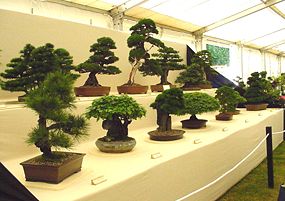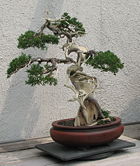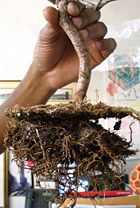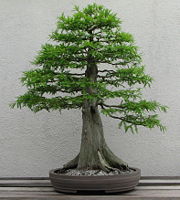Bonsai listen (help·info) (Japanese: 盆栽, literally "potted plant") is the art of aesthetic miniaturization of trees by growing them in containers. Cultivation includes techniques for shaping, watering, and repotting in various styles of containers.
Originating in China during the Han Dynasty, 'bonsai' is a Japanese pronunciation of the Chinese word penzai (盆栽). The word bonsai has been used in the West as an umbrella term for all miniature trees.
History
The origins of bonsai are believed to have begun nearly 2000 years ago during the Han Dynasty in China. It has since developed into new forms in parts of China, Japan, Korea and Vietnam.
At first, the Japanese used miniaturized trees grown in containers to decorate their homes and gardens. During the Tokugawa period, landscape gardening attained new importance. Cultivation of plants such as azalea and maples became a pastime of the wealthy. Growing dwarf plants in containers was also popular. At this time, the term for dwarf potted trees was "a tree in a pot" (鉢の木, hachi-no-ki?).
The c.1300 rhymed prose essay, Rhymeprose on a Miniature Landscape Garden, by the Japanese Zen monk Kokan Shiren, outlines the aesthetic principles for bonsai, bonseki and garden architecture itself.
The oldest known living bonsai trees are in the collection at Happo-en (a private garden and exclusive restaurant) in Tokyo, Japan, where bonsais are between 400 to 800 years old.
Cultivation
Bonsai are not genetically dwarfed plants. They can be created from nearly any tree or shrub species and remain small through pot confinement and crown or root pruning. Some specific species are more sought after for use as bonsai material because they have characteristics that make them appropriate for the smaller design arrangements of bonsai.
Read more at Wikipedia.org





